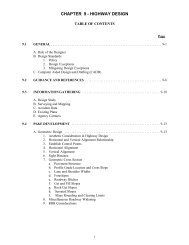Baltimore-Washington Parkway Widening Feasibility Study
Baltimore-Washington Parkway Widening Feasibility Study
Baltimore-Washington Parkway Widening Feasibility Study
- No tags were found...
You also want an ePaper? Increase the reach of your titles
YUMPU automatically turns print PDFs into web optimized ePapers that Google loves.
<strong>Baltimore</strong>-<strong>Washington</strong> <strong>Parkway</strong> <strong>Widening</strong> <strong>Feasibility</strong> <strong>Study</strong>Executive SummaryThe estimated capital costs of adding a third northbound lane and a third southbound lane tothe B-W <strong>Parkway</strong> range from approximately $343 million for the least expensive inside wideningoption to approximately $565 million for the most expensive outside widening option.No general public consensus was identified on either the need or the desirability of undertakingany potential widening option, with views regularly being expressed to both retain the existingfacility as a true <strong>Parkway</strong> and to advance the widening concept.The potential magnitude of physical change associated with the widening of the B-W <strong>Parkway</strong>mainline would require that a determination of potential impairment of the facility be made bythe NPS. This assessment would have to be undertaken in association with any future NEPAevaluation.Moreover, several other issues were identified that will merit closer attention if funding is identified forthe more comprehensive studies that would be required prior to the initiation of any formal design oractual construction activities. These issues include, but are not limited to, the following:Consideration of the traffic needs of the B-W <strong>Parkway</strong> within the context of the existing andfuture network of transportation facilities and services in the entire <strong>Baltimore</strong> to <strong>Washington</strong>,DC, travel corridor. How the <strong>Parkway</strong> interacts with traffic from these other facilities isimportant to fully understand the best way to accommodate these expected future demands.Consideration of a wider array of options for addressing traffic and transportation needs on theB-W <strong>Parkway</strong> itself and within the larger study corridor, including examining additional wideningoptions for the <strong>Parkway</strong> and other highway facilities, traffic management options, and optionsfor the use of multiple travel modes such as high occupancy vehicle lanes, bus-only lanes or busrapid transit, fixed guideway transit facilities, and managed lanes.Examination in much greater detail of the effects of all options on the natural, socioeconomic,cultural, and built environments. A proactive public and agency process will ensure properidentification of critical resources as well as strategies for minimizing, avoiding, and mitigatingpotential impacts.Incorporation of designs that will address the need for reconstruction or replacement of themany bridges and interchanges along the corridor in a context-sensitive manner, respectful ofthe B-W <strong>Parkway</strong>’s documented history and established character.A careful examination of the implications of impairment on the status of the B-W <strong>Parkway</strong> asone of the region’s premier NPS resources.This initial feasibility study makes no definitive recommendations for any further examination of thepotential widening of the B-W <strong>Parkway</strong>. Rather, it identifies the major factors that would need to beexamined in substantially more detail if the decision were made to pursue any such changes to theexisting facility at some future date.15 November 2012
















